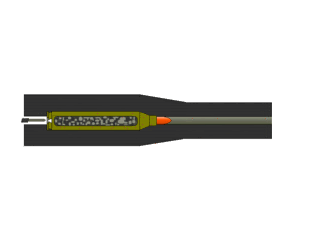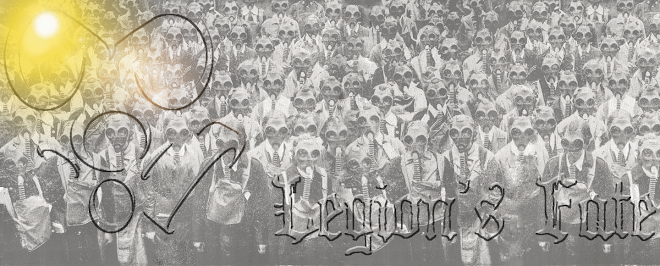Here is a picture showing the components. On the left is a .223 Remington rifle cartridge, and on the right is a .44 Magnum pistol cartridge. This is the breakdown:

- The cartridge. A cartridge is a group of components fit into a metallic case that can be fired in a firearm.
- The bullet. This is the projectile that is discharged from a firearm. They are made of many materials including lead, copper and lead, bronze, and brass. Some are designed to break apart on impact, expand on impact, or just penetrate with little or no expansion. The most common bullets are made of lead with a copper jacket.
- The cartridge case. The case holds all of the components and protects them. Usually made of brass, sometimes the case is made of aluminum or steel.
- The case head. This is the strongpoint of the case. The hole in the case head is the primer pocket.
- The primer. The primer is struck by the firing pin of the firearm causing it to emit a small but very hot flame, which starts the firing process by igniting the propellant.
- The propellant. The propellant for modern cartridges is a smokeless type of gunpowder which when ignited turns into a gas. The gas pushes the bullet down the barrel of the gun and out of the muzzle.
That is all there is to a metallic cased cartridge or a "round," as in "rounds of ammunition." Here is an animation showing how a cartidge is fired in a gun:

Pistol cartridges generally fire a heavy bullet at slow velocities. A .45 ACP fires a 230 grain, .45 caliber bullet at around 850 feet per second (FPS). The effectiveness of a pistol cartridge depends on the size, or caliber, of the bullet and other factors like the amount of propellant in the case. They are useful at close range for hunting or personal defense. Most hunting or defensive pistol bullets are copper jacketed hollowpoints which are designed to expand in a controlled manner inside of the target. Contrary to popular belief, hollow points are not designed to penetrate bullet resistant vests and are actually less effective than other designs such as full metal jacketed bullets.
Full metal jacketed bullets are desiged for penetration. These are used almost exclusively in combat by our troops. They are easy to manufacture making them ideal for target practice. Since they do not expand, they penetrate farther in a target and cause less tissue damage than hollowpoints, which is why they are not often used for defense. A 9mm or .45 caliber full metal jacketed bullet can penetrate through a person and still be a danger to anyone in the line of fire. Hollowpoints generally stop inside the target making them a safer choice for personal defense.
Rifle cartidges generally fire a lighter projectile at high velocities. Like pistol cartridges, the effectiveness is determined by the caliber of the bullet, the shape of the case, and the amount of propellant in the case. The 7.62x39mm cartridge fires a 115 grain, .30 caliber bullet at about 2,400 fps. The .300 Winchester Magnum fires a 180 grain, .30 caliber bullet at up to 3,000 fps.
Rifles are used for all ranges; from close range for house clearing or dangerous game, mid range for hunting or sniping, or long range for competition, sniping, experienced hunters or fun. Rifles are incredibly versatile and can be used for just about any purpose, and the proper cartridge has to be considered to that end. A .22 magnum would not be considered to stop a charging bear, and a .460 Weatherby Magnum would be considered overkill for groundhogs.
Next up is a shotgun shell, or shotshell. Here are the components:
- Shotshell. This is the unfired shell as it would be loaded into a shotgun. The translucent and red shotshells on the right and left are 12 guage highbrass shells and the yellow shotshell in the center is a 20 guage lowbrass shell.
- Shot. Pictured here is birdshot, buckshot, and a slug.
- Shotshell hull. This holds all of the components together. This one is made of plastic with a brass base. Low brass cases are used in low powered shotshells, high brass cases are used for high powered shotshells such as buckshot or slugs.
- Shotcup or Wad. This holds the shot together until it exits out of the muzzle of the shotgun. After it exits it will slow down and allow the shot to continue on its path.
- Propellant. When ignited the propellant turns into a gas which pushes the slug or shot out of the muzzle.
- Slug. Inside the translucent hull is the soft lead slug.
- Primer. Not pictured. The primer is struck by the firing pin of the shotgun causing it to emit a small but very hot flame that ignites the propellant. This is a 209 primer which is sometimes used on a muzzle loader.
Shotgun shells started out using brass as a case, or hull as it's called today. Other stuff was also used for the hull like paper, but then the shells were not water resistant. Todays modern shotgun shells use a plastic hull with a brass base.
Buckshot is often used by military, police, and citizens for personal defense against a human threat. Buckshot fires as many as 45 pellets and as little as 8 pellets depending on the size of the shot and the guage of the shotgun, making it very useful for putting many holes in a target at one time. Buckshot is used at close range where it is devastating on a soft target. At ranges beyond 50 yards it looses its effectiveness because the shot spreads out enough that a single target cannot be engaged.
Buckshot has endless versatility. It is used to blow off locks, blow out door hinges, and pop tires. At close range, buckshot can be very effective at stopping a felon or insurgent driving a car. Hollywood and anti-gun people have spread some myths about buckshot, the most prominent being that you can "cover a wall" with a shotgun using buckshot, meaning that the gun can be fired without aiming and still hit the target. This of course is false. Buckshot fired in a home or a building will spread out very little, often times making almost one hole at distances of 30 feet or less.
Shotgun shells can be loaded with single projectiles as well. This can vary from beanbags and wooden dowels for less-than-lethal situations, to fin stabilized explosive charges used by Marines to open doors. By far the most popular is the slug, which as you will see in part three of this series can be devastating.
A slug is usually made of soft lead but now technology has made some types of slugs as effective as a rifle by using a copper jacketed bullet. Most slugs are used within 100 yards, but some more advanced types can be used out to 200 yards or more. Hunters often use slugs for killing deer, or for large and dangerous animals like bears or lions. A 12 guage shotgun loaded up with slugs is very comforting when one is around animals that can kill you.
The last bit covered will be muzzle loaders. This is the same technology that was used in the American Revolution and the American Civil War. Muzzle loaders do not fire cartridges. They have to be loaded from the muzzle with gunpowder and then a bullet, and lastly primed with a priming cap or a shotgun primer.
Modern muzzle loaders use newer technology to make them more accurate, more reliable, and to increase their range. Copper jacketed bullets are now used to help control the expantion of the bullet and to make them more aerodynamic for accuracy. Shotgun primers are often used instead of priming caps because they are more water resistant and produce a hotter flame. Modern muzzle loaders can humanely take game out to 250 yards or more making them a very capable but one shot weapon.


No comments:
Post a Comment